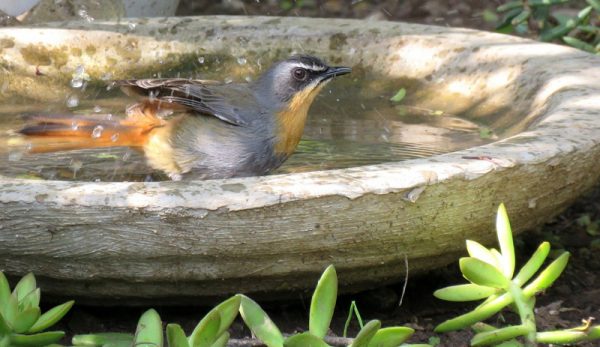
If you regularly offer wild birds seeds, nectar or fresh water, you’d better have a good scrub brush and a jug of bleach on hand—and plan to use them a lot. That’s because moldy seed, spoiled nectar and filthy birdbaths can spread disease to visiting birds.
“One of the most common diseases that spreads at bird feeders is a form of salmonella that results in conjunctivitis,” says Dawn Hewitt, the editor of Bird Watcher’s Digest and Watching Backyard Birds.
Commonly affected birds like house finches and goldfinches lose their eyesight and eventually starve.
Birds can also develop fatal respiratory conditions if they inhale certain fungal spores. (Damp, moldy seed is usually the culprit.) Sadly, when sick birds mix with healthy ones, the sick birds further contaminate shared areas.
Feces and dropped seeds and hulls can harbor viruses, bacteria and even single-celled parasites.
Learn how to make homemade suet cakes to feed wild birds.
Elbow Grease
Fortunately, you can greatly reduce birds’ potential exposure to these pathogens.
“If you’re going to offer bird feeders to help the birds or even just for your own enjoyment, you are not helping them if your feeders are dirty,” Hewitt says.
She recommends scrubbing and disinfecting bird feeders at least monthly.
“But it really depends on how heavily used your bird feeders are,” Hewitt adds. If you see multiple bird flocks each day or if it recently rained and your seed got wet, you should clean them even more often.
“Scrub out all the gunk!” Hewitt says.
To deep-clean her bird feeders, Hewitt first takes them apart. She suggests using a bucket of warm, soapy water and a scrub brush—or, in some cases, an old toothbrush—to get into tiny crevices. “I even scrub the nuts and screws that are holding the perches to the [feeder] tube, because germs are tiny,” she says.
Next, she rinses the parts in a solution of one part bleach to nine parts water. She finishes with a plain water rinse to eliminate any bleach residue or smell.
Before refilling, she allows feeders to dry completely.
Hummingbird Feeders
Many people replace their seed feeders with hummingbird feeders during spring and summer. If you’re among them, you should still deep clean bird seed feeders before storing for the season. And be advised that hummingbird feeders require regular upkeep, too.
“People don’t realize that nectar—especially if that feeder is hanging in the sun—can spoil really quickly,” Hewitt says. Nectar can ferment or become moldy. She continues, “When nectar becomes moldy, it can kill the hummingbird.”
To keep hummingbirds healthy, plan to replace old nectar with a fresh batch at least every few days.
“Depending on the temperature, maybe you can go a week, but that’s really pushing it,” Hewitt says. “It needs to be emptied and not just refilled. It needs to be emptied and washed.”
As with seed feeders, wash hummingbird feeders with soap and water. Next, rinse with a one-to-nine-part bleach solution, and then rinse well with plain water to remove traces of bleach.
Rather than purchase commercial blends, Hewitt makes her own hummingbird feeder solution.
“It’s four parts water to one part sugar,” she says. “That’s the right formulation that closely simulates the natural sugar concentration in flowering plants, and it seems to be what hummingbirds want.”
Check out this easy, DIY bird feeder that you can make with your children!
Birdbaths
To safeguard against disease, you also need to scrub any birdbaths you put out. That means dumping old water, rinsing well and replacing with fresh water every day.
Hewitt usually uses plain water and a scrub brush. But when she’s cleaning her bird feeders she sometimes also disinfects her birdbaths with bleach solution.
“And then rinse really well again,” she cautions.
Agitating the water with solar fountains, drippers or misters can attract more birds, but Hewitt adds, “That doesn’t mean you can get away with not cleaning your birdbath.”
What’s more, keeping birdbaths in direct sunlight isn’t ideal. “Most birds want the birdbath to be in the shade,” she says. “They want cold water on a hot day.”
Birdhouse Basics
Nest boxes require less upkeep.
“It is more natural not to clean nest boxes,” Hewitt says. “I certainly don’t apply any chemicals or wash them with bleach. I just take [any old] debris out.”
Previously occupied birdhouses can harbor parasites. To remove them, Hewitt dry brushes the inside of [unoccupied] nest boxes each spring.
“And, in the fall, I do the same thing, but I put dried grass at the bottom of the box for a little bit of insulation that they can use for winter,” she says.




